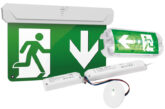
Peter Adams, Technical Manager at NVC Lighting looks at the different types of emergency lighting system and explains why battery care is such an important consideration.
Emergency lighting is a safety critical system which is a mandatory requirement for all commercial premises. It can be separated into two different types of system: self-contained and centrally powered.
A self-contained or ‘single point’ system consists of luminaires which include all the necessary components to operate them in mains and emergency mode, housed integrally to the luminaire or within one metre of it.
Alternatively, a centrally powered system comprises a slave inverter or change-over inverter locally to the luminaire, with the battery cabinet housed remotely, elsewhere within the building.
Both systems use alternative sources of power to provide illumination in a real-life emergency and during sustained power failures, in the shape of a battery pack. The battery is crucial to the on-going performance of the system and so should be chosen wisely, with particular attention paid to its correct specification, designation, and quality of performance.
Moreover, it is essential that the battery is looked after and operated within its correct parameters throughout its design life. For emergency lighting, this life is four years, in line with the Self-Contained Emergency Luminaire standard, BS EN 60598-2-22:2014.
The four main chemistries of battery packs used for emergency lighting are: Valve regulated lead-acid (VRLA), Nickel-Cadmium (Ni-Cad), Nickel Metal-Hydride (Ni-MH) and Lithium (typically LiFePO4).
All four are rechargeable and must conform to specific battery standards for performance and safety. It is paramount that the chosen battery is compatible with the control gear used, however, it cannot be assumed that it will continue to perform to a high level if not cared for appropriately.
Over-cycling, incorrect charge regimes, excessive temperatures and accidental deep-discharge can, and frequently will, contribute to a drop in performance and an inability of the battery to satisfy its design life.
It is no coincidence that many emergency lighting luminaire producers and manufacturers experience high volumes of aftersales enquiries specifically related to batteries and their premature failure.
This has occurred for many years across countless electrical installations and is often down to a lack of education and awareness of how the battery must be stored and operated both prior to and during application.
The system should be tested and maintained in accordance with BS EN 50172:2004 and EN 62034 if using an automatic self-test system. This equates to one full annual duration test and a monthly functional check.
It is equally important to perform daily or weekly routine visible inspections of the charge indicator which will provide the initial status of the health of the battery and luminaire. Care should also be taken to ensure that the operating temperature of the installation remains within the maximum tolerances of the battery (around 50?C for Ni-Cad and Ni-MH and 55?C for Lithium).
A lack of scheduled maintenance, incorrect and overzealous testing, combined with harsh environmental factors can all impact adversely on the battery, but by following these guidelines and avoiding accidental misuse and abuse throughout, there’s no reason why the battery shouldn’t satisfy and even exceed its designed life.
View the NVC Emergency Lighting catalogue here.








